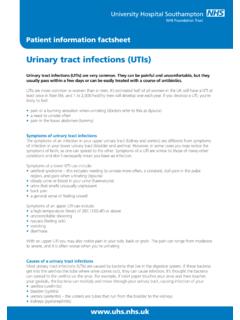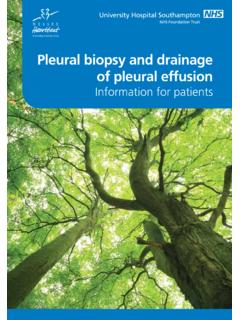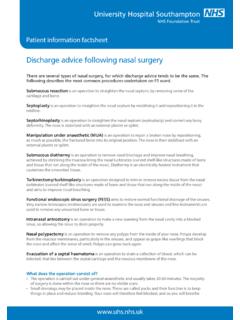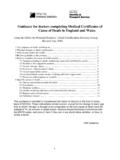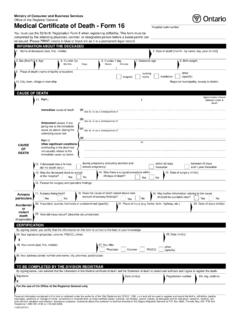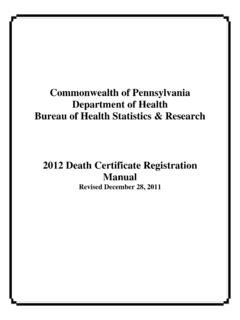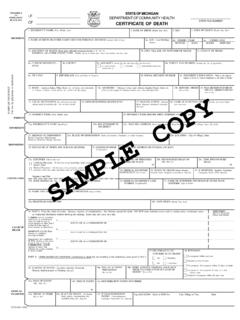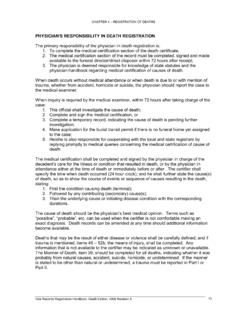Transcription of Medical Certificate of Cause of Death Notes for …
1 Medical Certificate of Cause of Death Notes for Doctors THE Medical Certificate OF Cause OF Death 1. 2. Your duties as a Medical 3. Personal details of 4. Circumstances of 5. When to refer to the 6. Cause of Death 7. Employment-related 8. Signature of certifying doctor and name of 9. The back of the 1. INTRODUCTION Prompt and accurate certification of Death is essential. It provides legal evidence of the fact and Cause (s) of Death , thus enabling the Death to be formally registered: the family can then make arrangements for disposal of the body. Death certification also provides the raw data from which all mortality statistics are derived. These are vital for public health surveillance, for resource allocation in the NHS, and for a wide range of research and thus ultimately for improving the health of the population.
2 2. YOUR DUTIES AS A Medical PRACTITIONER If you are a registered Medical practitioner and were in attendance during the deceased s last illness, you are required under the Births and Deaths Registration Act 1953 to certify the Cause of Death . You must state the Cause or causes of Death to the best of your knowledge and belief (see section 6). If you judge that the coroner may need to be informed, see Section 5. Death certification should preferably be carried out by a consultant or other senior clinician. Delegation of this duty to a junior doctor who was also in attendance should only occur if he/she is closely supervised. There are three kinds of Certificate : i) Medical Certificate of Cause of Death (this book) (form 66): Any Death occurring after the twenty-eight days of life should be certified using the Medical Certificate of Cause of Death .
3 Ii) Neonatal Death Certificate (form 65): Any Death of a live-born infant occurring within the first twenty-eight days of life should be certified using the Neonatal Death Certificate . iii) Certificate of Still-birth (form 34): Any Death of an infant that has issued forth from its mother after the twenty-fourth week of pregnancy and which did not breathe or show any other signs of life at any time after being completely expelled from its mother should be certified using the Certificate of Still-birth. Any infant that has breathed or shown any other sign of life is considered as live-born for registration purposes, irrespective of the period of gestation. Still birth certificates should not be used for such infants. The different forms of Certificate may be obtained on request from registrars of births and deaths.
4 The forms in this book must not be used for still-births or neonatal deaths. You are legally responsible for the delivery of the Death Certificate to the registrar. You may do this personally, or by post, or you may ask the relative or other person who is able to give information for the Death registration to deliver is as your agent. Envelopes for the purpose of delivering certificates are available from the registrar. Before arranging the delivery of the Death Certificate to the registrar, please ensure that you also complete the Notice to informant . This notification must be handed to the relative or other person responsible for registering the Death . You should complete the counterfoil for your record in all cases. HOW TO COMPLETE THIS Certificate 3.
5 PERSONAL DETAILS OF DECEASED Age you should record the age of the deceased in completed years or, if under one year, in completed months. Place of Death you should record to the best of your knowledge the precise place of Death ( the name of the hospital or the address of a private house or, for deaths elsewhere, the locality). This may not be the same as the place where you are completing the Certificate . It is particularly important that the relative or other person responsible for registering the Death is directed to the registrar of births and deaths for the sub-district where the Death occurred, unless (from 1st April 1977) they have decided to make a declaration of the details to be registered before another registrar.
6 4. CIRCUMSTANCES OF CERTIFICATION Last seen alive by me you should record the date when you last saw the deceased alive, irrespective of whether any other Medical practitioner saw the person alive subsequently. Information from post-mortem you should indicate whether the information you give about the Cause of Death takes account of a post-mortem. Such information can be valuable for epidemiological purposes. If a post-mortem has been done, ring option 1. If information may be available later, do not delay the issue of your Certificate , ring option 2 and tick statement B on the reverses of the Certificate . The registrar will then send you a form for return to the Registrar General giving the results of the post-mortem. If a post-mortem is not being held, ring option 3.
7 Seen after Death (only one option can be ringed) you should indicate, by ringing option a, b or c, whether you or another Medical practitioner saw the deceased after Death . 5. WHEN TO REFER TO THE CORONER There is no statutory duty to report any deaths to a coroner. You are nevertheless encouraged to report voluntarily any Death that you judge would need to be referred to the coroner by the registrar of births and deaths (see Section ). Reporting to the coroner you should indicate whether you have reported the Death to the coroner by ringing option 4 on the front of the Certificate and initial box A on the back. You should report to the coroner any Death that you cannot readily certify as being due to natural causes . A Death should be referred to the coroner if; the Cause of Death is unknown the deceased was not seen by the certifying doctor either after Death or within 14 days before Death the Death was violent or unnatural or was suspicious the Death may be due to an accident (whenever it occurred) the Death may be due to self-neglect or neglect by others the Death may be due to an industrial disease or related to the deceased s employment the Death may be due to an abortion the Death occurred during an operation or before recovery from the effects of anaesthetic the Death may be suicide the Death occurred during or shortly after detention in police or prison custody.
8 In addition to this list, the registrar of births and deaths is required to report to the coroner any Death for which a duly completed Medical Certificate of Cause of Death is not obtained. 6. Cause OF Death STATEMENT This section of the Certificate is divided in Parts I and II. Part I is used to show the immediate Cause of Death and any underlying Cause or causes . Part II should be used for any significant condition or disease that contributed to the Death but which is not part of the sequence leading directly to Death . Part I It is essential that you state the Cause (s) of Death accurately and fully to the best of your knowledge and belief. The Death Certificate is the relatives permanent legal record of the Death . The mortality statistics derived from the Death Certificate are vital for public health surveillance and other purposes.
9 Underlying Cause of Death you should approach this by considering the main causal sequence of conditions leading to Death . You should state the disease or condition that led directly to Death on the first line [I(a)] and work your way back in time through the antecedents of this condition until you reach the Underlying Cause of Death , which initiated the chain of events leading ultimately to Death . The lowermost completed line in Part I should therefore contain the Underlying Cause of Death . Example 1 An acceptable sequence for Part I A patient died from an intracerebral haemorrhage caused by cerebral metastases from a primary malignant neoplasm of the left main bronchus.
10 This should be entered as follows: I (a) Intracerebral haemorrhage (b) Cerebral metastases (c) Squamous cell carcinoma of left main bronchus Underlying Cause of Death Intermediate Cause of Death Disease or condition that led directly to Death The Underlying Cause of Death in this case is squamous cell carcinoma of the left main bronchus. For some deaths there may be only one condition which led directly to Death with no antecedents, subarachnoid haemorrhage or meningococcal meningitis. In this case it is perfectly acceptable to complete only line [I(a)]. Your statement of the Cause of Death should be as specific as your information allows.



